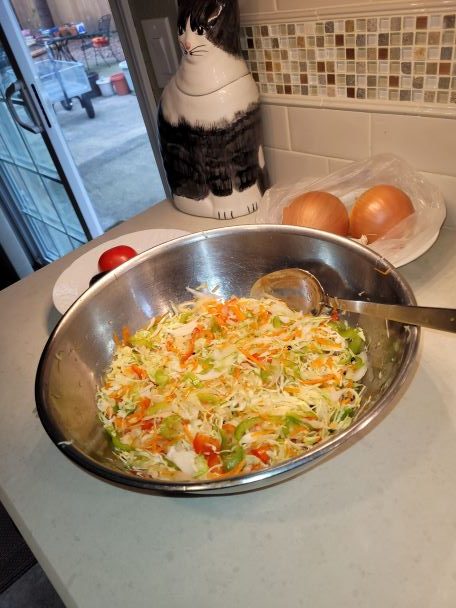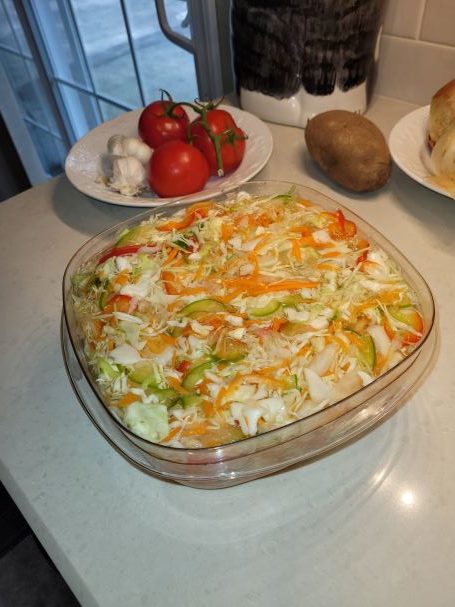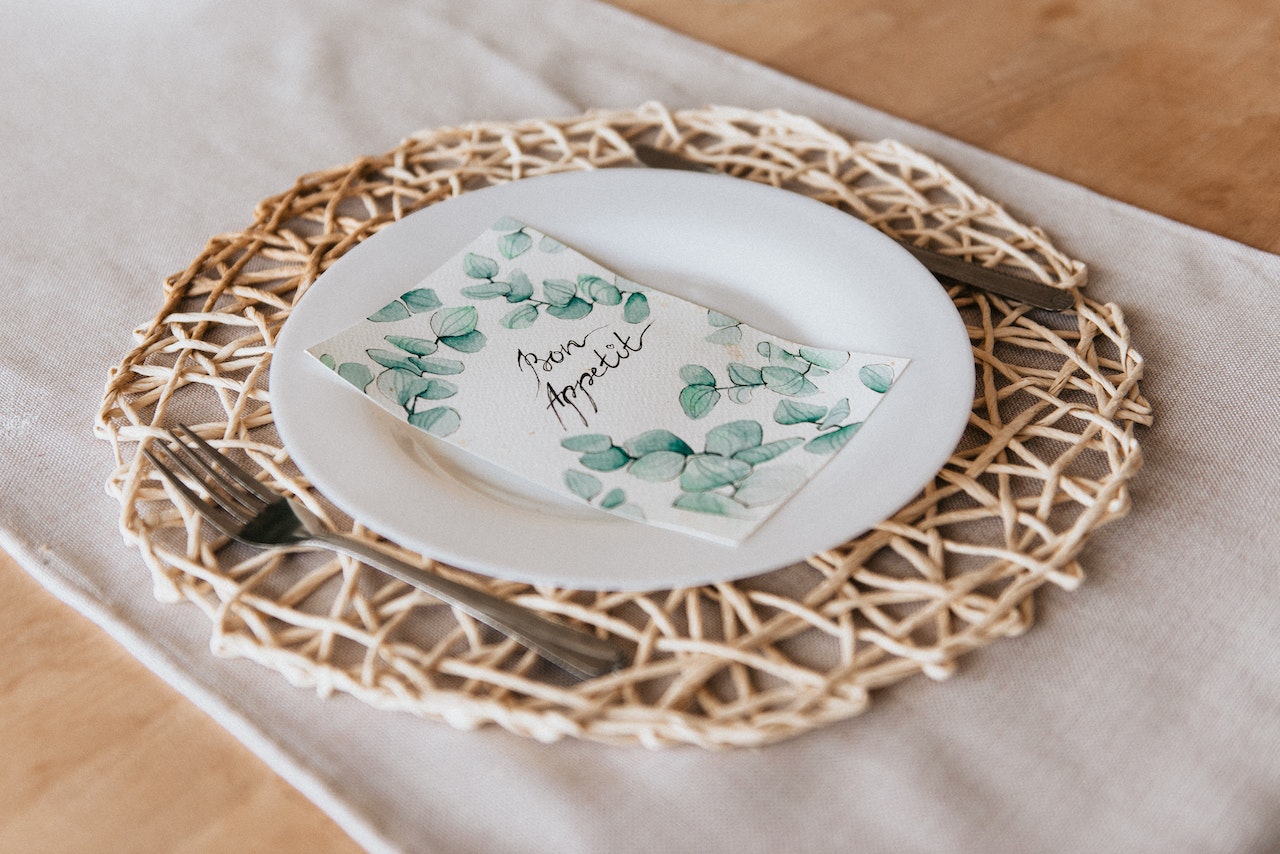I’ve been studying Haitian Creole for more than a year, and with some patience on the part of listeners, I can have a conversation.
But learning a new language isn’t something to be done on its own. To understand the language you must also learn the culture that created it and the people who are its creators. And learning that culture means learning history and social dynamics and all that goes with creating an identity.
Among these are the foods and dishes that the people of that culture have created as a way to not only feed themselves but to also express themselves. Before the advent of refrigerated trucks and ships food was prepared from local goods, and so many foods we might think of as exotic or unusual are just what people did with the foods that their grew, captured, or traded for with others.
In learning about Haiti, you must learn of Haitian foods, which are varied, typically including local foodstuffs, and influenced by the incredible mix of peoples and cultures that have been a part of making this island nation what it is. Eating Haitian food is an experience—you might not always like it because it tastes “foreign” to you, but generally, you’ll find it well-prepared and popular, and typically available throughout a region.
One of the foods I particularly have grown to like is Haitian Pikliz, which in its crudest sense is pickled cabbage. But it’s unlike what I might have expected as someone who likes cabbage in many forms—fried with pork, shredded in cole slaw, wrapped around a serving of meat and rice, or just as an ingredient of East Asian food.
I had it first in a Haitian restaurant (Zeke’s) near Atlanta, Georgia, and I was immediately in love with the taste, the texture, and the mix of heat with sourness and sweetness. I had two servings of it because it was so good, and it became something I had to figure out how to make for myself. Which I have now done so.
And let me tell you, you just cannot get into Haitian culture if you don’t at least try a bite of pikliz. It’s colorful and flavorful with a kick of spice, and to me, it epitomizes the liveliness not just of Haitian cuisine but of Haitian culture. It’s something you have when you’re with family, when you’re out for a meal in a Haitian restaurant, when you want a low-calorie no fat snack that’s packed with vitamins and pre-biotics. This is a family dish, and eating this is part of being with family.
As for preparation, it’s not truly pickled as you might think of pickled vegetables. The ingredients are not cooked and are not stored for a lengthy period. Typically it’s prepared for use close to the day of serving, but it’s not left long enough to truly ferment, and it’s nothing like sauerkraut.
Instead, it’s mostly thinly sliced vegetables with certain spices left in a brine of vinegar and citrus juice with enough salt for taste long enough for the vegetables to be ever-so-slightly transformed and melded into a flavorful, spicy dish that goes great with fried foods such as griyo or peze.
I’ve made it now, twice, and in making it I’ve made it my own. Like most recipes for national foods, there is no one single recipe, and no one will make it exactly the same.
But there are certain ingredients that seem to be standards, and I’ve used most of them, eliminating some due to lack of access, difficulty of preparation, or a dislike of the actual taste or experience of eating it.
Here is the recipe I started from, loosely based upon the one I found in The New York Times. I think the proportions for the main ingredients are not exact, so don’t fuss too much. The only thing I’d keep an eye on are the use of the Scotch bonnet peppers because the amount of heat they bring to the pikliz can be overwhelming if you’re not prepared for it. But when you hit the right amount/proportion, they add that necessary touch of heat that contrasts so well with the foods that you serve it with.
RECIPE FOR HAITIAN PIKLIZ
Ingredients:
1 green cabbage.
1 large onion
2 bell peppers, in contrasting colors. I typically use green and red.
2-6 garlic cloves. I tend to really like garlic, so I lean towards the high number.
2-4 scallions / green onions
2 large carrots
4-6 Scotch bonnets or habanero chiles
6 black peppercorns *
4 whole cloves *
1-2 springs fresh thyme *
2 limes
Handful of salt **
White vinegar
(Items marked with a single “*” are optional. I added all three for my first batch, but it didn’t match the flavor of the pikliz I had in the restaurant, so for my subsequent batches I left it out. Plus, they look like little black or brown “nubs” in the mix, and biting into one is not, in my opinion, pleasant. Salt (**) is also optional, but I found it necessary to push the flavor up.) Note that there is no oil or sugar added.
Substitutions:
You can substitute cider vinegar, but I prefer the neutral taste of white vinegar. If you don’t have limes, you could use fresh lemon juice, but to me it changes the flavor profile quite a bit – the sweetness of the lime juice helps to bring out the sweetness of the carrots as they meld together in the marinade.
Scotch bonnets are preferred over habaneros for the authentic flavor, but the tastes are similar. Be warned that Scotch bonnets are far hotter than habaneros. You really do need the kick of the extra spicy chiles, though. Jalapenos and the like just don’t give it the right taste.
Be judicious with the number of chiles that you use. The first time that I made this I doubled the amount of Scotch bonnets, and although I like spicy food, it was way way hotter than I expected, so hot that my lips were numbed and my tongue buzzed with the overstimulation. Capsaicin is used for the treatment of joint aches caused by diseases such as rheumatism and arthritis because it overstimulates nerve endings so that they stop transmitting pain signals. And I think that over-inclusion of capsaicin just about thrashed my poor taste buds – but I ate every bit of that first batch!
Some recipes use chicken boullion (“Maggi”), which seems to be a common ingredient in Haitian cooking. I didn’t have it prepared that way when I had it, so I prefer it without using that.
Preparation:
Note: Before handling spicy peppers such as Scotch bonnet peppers or habaneros, wear disposable gloves and wear eye protection.
Wash the cabbage, carrots, scallions, chiles, bell peppers. Peel the onion and the carrots. Remove the skins from the garlic cloves.
Cut the cabbage into quarters. Remove the thick stem from each quarter. Cut the carrots into 2-3″ long sections. Open the chiles and remove the stems. Deseed only if you want less spicy results. Open the bell peppers, deseed, and remove the white sections.
Using either a chef’s knife or a mandolin slicer, slice the cabbage into strips about 1/4-1/8th inch wide. Do the same with the onion and the bell peppers. Chop the scallions into thin “rounds”. Julienne the carrots. If you do not have a julienne attachment to your mandolin slicer, slice them as thinly as possible. Finely slice the chiles. Finely dice the garlic, or use a garlic press to make sure that the garlic releases as much flavor as possible. Roll and press the two limes to get as much juice as possible, then halve and juice them.
Put all the sliced/chopped ingredients into a non-reactive bowl. (The capsaicin of the chiles can stain plastic bowls or infuse the plastic with the capsaicin oil, and it’s very difficult to remove that, which means that bowl will flavor other foods you make in it.) Add the salt, thyme, peppercorns, and salt. Pour the lime juice over everything.
Mix thoroughly in the bowl, then cover and let it set in the refrigerator for a while. I leave mine for about 30 minutes so that the salt and juices can begin working.
After letting it set, put all the ingredients into glass jars or stain-proof containers (so they don’t pick up the capsaicin), and pack firmly. You want to leave about a half-inch or so at the top of the container.
Cover the ingredients with enough white vinegar so that none of the ingredients are exposed to air.
Close the lid of the containers or jars and put them into your refrigerator.
While it could be served right away or even the next day, it reaches the start of peak flavor and texture after three days. (I’ll bet you can’t wait that long, but try.)
Preparation notes:
I can’t stress enough that you should use gloves and eye protection when working with chiles. The first time that I made this I didn’t pay attention, and although I never touched my eyes, it proved impossible to get all the capsaicin oil off my hands, and that meant that the tiniest crack in my skin became a point of fire. It took three days before my hands stopped feeling as if they were being pricked with hot needles.
The pikliz I get in restaurants is sliced about 1/4″ thick. I use a mandolin slicer because I don’t have good control over knives anymore. The result is a much thinner slice, sometimes 1/16″ thick, which causes the pikliz to marinate and transform more quickly, and I much prefer it. But “true” pikliz is going to have thicker slices. Do what works for you, and don’t apologize!
Serving:
A serving size is about a half-cup for a plate. Use tongs or a fork to pull the pikliz from the jar or container. ALWAYS use clean tongs or forks when you dip into the pikliz because it has no preservatives, and you don’t want to contaminate it with stuff. The longer it’s in the marinade, the more the ingredients will absorb the flavors and the more the ingredients will soften. The marinade juice will start to look orange-y because the carrots are releasing their carotenoids.
Serve with fried pork (griyo), beef (tasso), eggs (it’s really good with bacon and eggs!), shrimp, white fish, fried plantains (peze), or other vegetables. Put on a pork or chicken sandwich. Add it as a side to a barbecue plate. It’s crunchy and spicy and flavorful, so anything where you might want a bright note of color, add it to the meal.


Main article image by Dmitry Zvolskiy on Pexels

